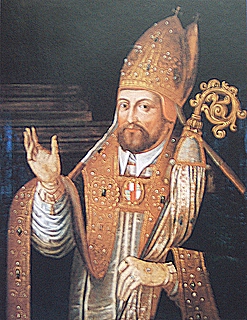Bishops in the Catholic Church facts for kids
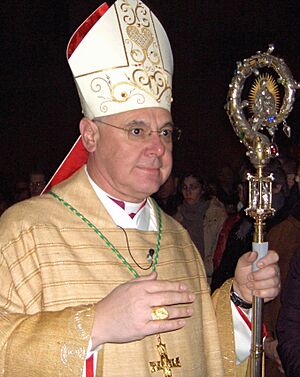
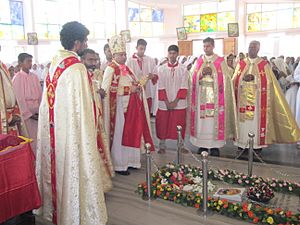
In the Catholic Church, a bishop is an important leader. Bishops are ordained ministers who have received the highest level of holy orders. They are responsible for teaching the faith, guiding Catholics in their area, making the world more holy, and representing the Church.
Catholics believe the role of bishop started with the apostles. It is believed the Holy Spirit gave the apostles a special gift and role at Pentecost. Catholics believe this special gift has been passed down through an unbroken line of bishops. This happens through the laying on of hands during the sacrament of holy orders.
Most bishops are Diocesan bishops. They lead local areas called dioceses in the Latin Church or eparchies in the Eastern Catholic Churches. All bishops together form the College of Bishops. They can also have other titles like archbishop, cardinal, patriarch, or pope. In 2020, there were about 5,600 bishops in the Catholic Church.
Bishops are always men. To become a bishop, a man must meet certain requirements. He needs to show strong faith, good morals, and care for others. He must also have a good reputation and not be married. He needs to be at least 35 years old and have been a priest for at least five years. Also, he should have a special degree in sacred studies or be an expert in them.
Contents
Diocesan Bishops: Leaders of Local Churches
The main job of a bishop is to lead a diocese or eparchy. These areas can be very different in size and population. Some older dioceses around the Mediterranean Sea are smaller. Newer ones, like in parts of Sub-Saharan Africa or South America, can be much larger.
When Bishops Retire
Since 1965, bishops are asked to offer their resignation when they turn 75. This is because their duties can become too much as they get older. John Paul II made this a rule for the Latin Church in 1983.
The rule says that a bishop who turns 75 should offer to resign to the Supreme Pontiff (the Pope). The Pope then decides what is best for the Church. Pope Francis also made this rule apply to non-cardinal bishops working in the Roman Curia in 2018.
What Bishops Do
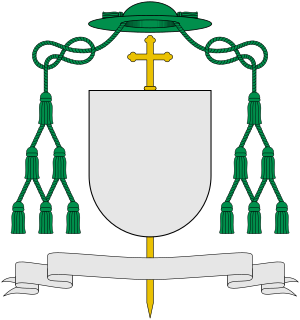
A diocesan bishop is in charge of a local Church (a diocese). He teaches, guides, and helps make the people of his diocese holy. He shares these duties with the priests and deacons who work with him.
To "teach, sanctify, and govern" means a bishop must:
- Oversee the preaching of the Gospel and Catholic education.
- Make sure the sacraments are given properly.
- Make rules, manage, and act as a judge for Church law matters in his diocese.
He is the main spiritual leader of the diocese. He is responsible for the care of all Catholics in his area. He must celebrate Mass every Sunday and Holy Day of Obligation for his people. He also assigns clergy to their jobs and manages the diocese's money. Bishops should especially care for priests, listen to them, and ensure they are well taken care of. Latin Catholic bishops also visit the Holy See (the Pope's office) every five years.
Only a bishop can give the sacrament of holy orders. This means only a bishop can ordain new priests or deacons. In the Latin Church, a bishop usually gives the sacrament of Confirmation. However, he can let a priest do it. In Eastern Catholic Churches, priests usually give Confirmation at the same time as baptism.
Only a diocesan bishop can bless churches and altars, though he can let another bishop or priest do it. On Holy Thursday, Latin Catholic bishops lead the Mass of the Chrism. At this Mass, they bless the special oil used for Anointing of the Sick. Only a bishop can make the holy oil called Chrism.
Bishops also approve theological books, making sure they are free from errors. This shows their role in teaching the faith.
Bishop's Authority
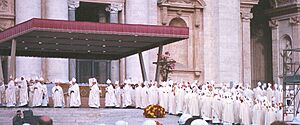
In both Western and Eastern Catholic churches, any priest can celebrate Mass or Divine Liturgy. However, to do so publicly, a priest usually needs permission from the local bishop. Traveling priests might carry a special document called a celebret to show they are in good standing.
For priests to hear confessions, they need permission from the local bishop. But if someone is in danger of death, any priest can hear their confession.
For marriage ceremonies, Latin Church priests and deacons need permission from the bishop. In the Latin Church, the couple themselves give each other the grace of the sacrament. So, in rare cases, a bishop might allow a lay person to be present for the vows. In Eastern churches, the clergy must also give a blessing for the marriage to be valid.
Any bishop can preach anywhere in the Catholic Church. Any priest or deacon can also preach anywhere with the local pastor's permission, unless their ability to preach has been limited.
The main church of a diocese is called a cathedral. It has a special chair called a cathedra for the bishop. This chair shows his spiritual authority.
Other Important Roles for Bishops
Bishops can have many other roles in the Catholic Church:
Bishop-elect
This is a priest who has been chosen to be a bishop but has not yet officially started his new role.
Titular Bishop
A titular bishop is a bishop who does not lead a diocese. They are given the title of a former diocese that no longer exists. Titular bishops often help diocesan bishops (as auxiliary bishops), work in the Roman Curia (the Pope's administration), or serve as papal representatives in other countries.
Suffragan Bishop
A suffragan bishop leads a diocese that is part of a larger church area called an ecclesiastical province. This area is led by a metropolitan archbishop.
Auxiliary Bishop
An auxiliary bishop is a full-time helper to a diocesan bishop. They are titular bishops and do not automatically take over when the diocesan bishop leaves. They help the bishop in many ways, often as general or episcopal vicars.
Coadjutor Bishop
A coadjutor bishop has almost the same authority as the diocesan bishop. They have special powers and the right to become the next diocesan bishop when the current one leaves. This helps ensure smooth leadership changes.
Bishop-Prelate
A bishop who holds an office that does not require being ordained as a bishop. This can be the Prelate of a personal prelature or a territorial prelature.
Emeritus Bishop
When a diocesan or auxiliary bishop retires, they are given the honorary title "emeritus." For example, "Archbishop Emeritus of Place." This title shows they used to lead that specific area. This practice became common after the Second Vatican Council when bishops were asked to resign at age 75.
Cardinal
A cardinal is a high-ranking member of the clergy chosen by the Pope. Cardinals under 80 years old elect a new pope when the current one dies or resigns. Cardinals also advise the Pope and hold important jobs in the Church's administration. Most cardinals are already bishops when they are chosen.
Archbishop
An archbishop is the head of an archdiocese, which is usually a very important diocese.
Metropolitan Archbishop
A metropolitan bishop is an archbishop who has a small amount of authority over an ecclesiastical province. This usually means they lead meetings and oversee a diocese that might not have its own bishop.
Pope
The pope is the Bishop of Rome. The Catholic Church believes that all bishops together are the successors of the apostles. The Church also believes that Saint Peter, the first Bishop of Rome, was given a special leadership role. Because of this, the Pope, as Peter's successor, has the unique right to speak for the whole Church, appoint other bishops, and manage the Church's central administration, the Roman Curia.
Pope Emeritus
When Benedict XVI resigned as Pope in 2013, he became Supreme Pontiff Emeritus. He was the only person to hold this title until his death in 2022.
Patriarch
In the Catholic Church, the title of patriarch is given to the head of an Eastern Church sui iuris (meaning "of its own law") or to a minor Latin patriarch. The patriarch of an Eastern Church leads an independent Church. A minor Latin patriarch is an honorary title given to some Latin dioceses for historical reasons.
Catholicos
Some Eastern Catholic Churches call their leaders catholicoi. This is an old title for the head of a Church. The Armenian Catholic Church, the Chaldean Catholic Church, and the Syro-Malankara Catholic Church use this title.
Major Archbishop
Major archbishops lead a major archiepiscopal church. Their authority within their Church is similar to that of a patriarch. However, their election needs to be confirmed by the Holy See.
Primate
In the Catholic Church, a primate is usually the bishop of the oldest diocese or the capital city of a country. It is an honorary title.
Public Office
Since 1983, Catholic clergy are not allowed to hold public office without special permission from the Holy See.
How Bishops Are Chosen
Choosing bishops in the Catholic Church is a detailed process. In the Latin Church, many people are involved. These include local Church leaders, the Pope's representative (nuncio), and different offices in the Roman Curia. The Pope makes the final decision. In Eastern Churches, the synod (a council of bishops) and the patriarch or major archbishop also help choose bishops.
Bishops and Other Churches
The Catholic Church teaches that bishops are part of a continuous line of leaders going back to the apostles. This is called apostolic succession. The Catholic Church recognizes the ordinations of the Eastern Orthodox, Old Catholic, Oriental Orthodox, and Assyrian Nestorian churches as valid.
The Second Vatican Council stated that Eastern Churches can govern themselves according to their own traditions. This is because their ways are well-suited to their people and good for their souls.
What Bishops Wear
Latin Church Dress
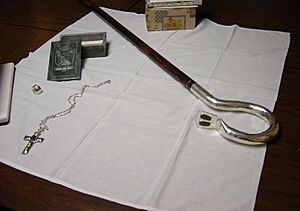
For everyday wear, Latin Church bishops might wear a black (or white in hot countries) cassock with purple trim. They also wear a pectoral cross (a cross on their chest) and an episcopal ring. Sometimes, they just wear a simple black suit and clerical shirt.
When attending Church services but not leading them, a bishop wears a purple cassock, a white rochet, a purple zucchetto (small skullcap), and a purple biretta (a square cap). He also wears his pectoral cross.
When leading Church services, a bishop usually wears a mitre (a tall, pointed hat), a zucchetto, and a stole (a long strip of cloth). For services other than Mass, he often wears a cope (a long cloak). In his own diocese, he also uses a crosier (a shepherd's crook). When celebrating Mass, a bishop wears a chasuble, like a priest.
Eastern Catholic Dress
Eastern Catholic bishops often wear similar everyday clothes to Latin Church bishops: a black clerical suit with a pectoral cross or panagia (an icon worn on the chest).
Byzantine Rite Catholic Dress
Traditionally, Byzantine Rite bishops are monks. So, their everyday clothes are often a monastic habit with a panagia. They might also wear a pectoral cross and a second panagia, depending on their rank.
When attending services, a bishop might wear a mantya (a cloak), a panagia, and an engolpion (another icon worn on the chest) if he is a patriarch or metropolitan bishop. He also carries a pastoral staff. There is no episcopal ring in the Byzantine Rite.
When leading the Divine Liturgy, a bishop wears a sakkos (a special tunic), an omophorion (a long scarf), and an epigonation (a stiff, diamond-shaped cloth). He also wears a Byzantine-style mitre, which looks like a closed crown and is often decorated with jewels and icons. This mitre is topped with a cross. He also carries a crosier in the style of his rite.
See also
- Catholic Church hierarchy
- Historical list of the Catholic bishops of the United States
- List of Catholic apostolic administrations
- List of Catholic apostolic prefectures
- List of Catholic apostolic vicariates
- List of Catholic archdioceses
- List of Catholic dioceses (alphabetical)
- List of Catholic dioceses (structured view)
- List of Catholic military dioceses
- List of Catholic missions sui juris
- List of Eastern Catholic exarchates
- List of the Catholic bishops of the United States
- List of the Catholic dioceses of the United States
- Lists of patriarchs, archbishops, and bishops


